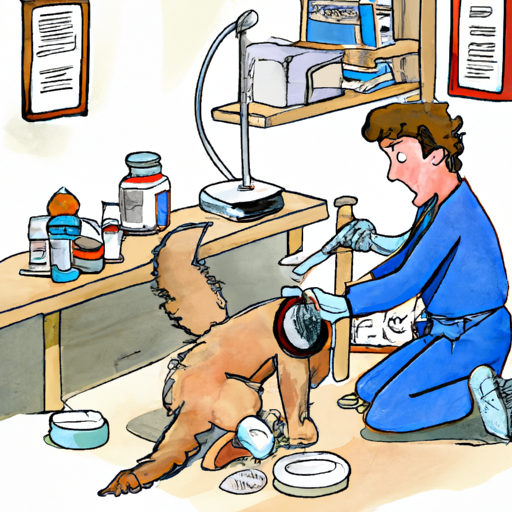When your furry friend gets a cut or scrape on their tail, it can be a scary experience for both of you. The tail is a particularly tricky area to treat due to its constant movement and the fact that dogs use their tails for communication. However, knowing how to stop a dog’s tail from bleeding is an essential skill for any dog owner. This article will guide you through the process step by step.
Table of Contents
- Understanding Tail Injuries
- Immediate Steps to Stop the Bleeding
- Professional Intervention
- Home Care and Monitoring
- Preventing Tail Injuries
- Frequently Asked Questions
Key Takeaways:
- Tail injuries, though common, can be potentially serious if not properly treated.
- Applying pressure and using a bandage are the immediate steps to stop tail bleeding.
- Seeking professional help is crucial, especially in severe cases.
- Home care and monitoring is important in the recovery process.
- Preventive measures can significantly reduce the chances of tail injuries.
Understanding Tail Injuries
A dog’s tail is an extension of their spine. It’s made up of small bones called vertebrae, surrounded by muscles, skin, and hair. Injuries can occur from various causes, such as accidents, fights with other animals, or even just wagging against hard surfaces—a condition known as “happy tail” syndrome.
Injuries to the tail can be painful and, in some cases, cause significant blood loss. A bleeding tail can also create quite a mess in your home, given the wagging nature of most dogs. It’s therefore important to address any tail injuries promptly and correctly.
Immediate Steps to Stop the Bleeding
As with any wound, the first step to stop a dog’s tail from bleeding is to apply pressure. Here’s a step-by-step guide:
- Clean your hands or wear gloves if available. This helps to prevent infection.
- Use a clean cloth or bandage and apply direct pressure to the wound.
- Hold pressure for a few minutes or until the bleeding stops.
- If blood soaks through the cloth, don’t remove it. Instead, add more layers and continue to apply pressure.
Once the bleeding is under control, you should bandage the tail. This not only helps to stop the bleeding but also protects the wound from further injury and infection. The American Kennel Club provides a detailed guide on how to properly bandage a dog’s tail.
Professional Intervention
While minor tail injuries can often be managed at home, it’s crucial to seek veterinary attention for more serious wounds. Signs that your dog may need professional help include:
- The bleeding doesn’t stop after 10 minutes of direct pressure.
- The wound is large, deep, or looks particularly nasty.
- Your dog is in obvious pain or distress.
- The tail appears broken.
In these cases, your vet may need to perform further treatment such as suturing the wound, administering pain relief, or even performing surgery in severe cases. It’s important to remember that while it can be stressful, getting your dog to the vet is the best thing you can do for them in these situations. For more details, One Top Dog has a wealth of information about dog health and when to seek veterinary help.
Home Care and Monitoring
Once your dog’s tail is bandaged and any necessary veterinary treatment has been provided, it’s time to focus on aftercare at home. This includes monitoring the wound for signs of infection, such as redness, swelling, or a foul-smell.
It’s also important to prevent your dog from chewing or licking the bandage. Products like bitter apple spray can help deter this behavior. Alternatively, you may need to use an Elizabethan collar (also known as a “cone of shame”).
Keep a close eye on your dog’s overall behavior too. Changes in appetite, energy levels, or demeanor can indicate pain or distress.
Preventing Tail Injuries
Prevention is always better than cure. There are several steps you can take to help prevent tail injuries in your dog:
- Keep your dog’s environment safe and free from hazards.
- Regularly check your dog’s tail for any cuts, scrapes, or signs of injury.
- Consider tail guards or bandages for breeds prone to tail injuries.
One Top Dog also has an interesting article about dog safety and dog tail guards that can provide further information.
Frequently Asked Questions
1. How long does it take for a dog’s tail to heal?
It depends on the severity of the wound. Minor cuts and scrapes may heal in a few days, while severe injuries may take weeks or even months.
2. Should I try to clean the wound myself?
It’s generally safe to clean a minor wound with warm water, but avoid using any harsh chemicals or human wound cleaners, which can cause further irritation.
3. My dog’s tail is still bleeding, what should I do?
If your dog’s tail is still bleeding after applying pressure and bandaging, you should seek immediate veterinary attention.
In conclusion, knowing how to stop a dog’s tail from bleeding is an important skill for any dog owner. Remember to act quickly, stay calm, and when in doubt, always seek professional help.



